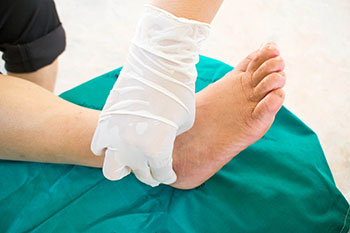Connect With Us
Wound Care

A foot wound is damaged skin and tissue that starts out as a cut or abrasion. Minor cuts on the feet of healthy individuals usually heal on their own, however for people with diabetes, even the slightest skin disturbance has the potential to become a wound and far worse if left untreated.
Why Wounds Are Troublesome for Diabetics
Nerve damage and circulatory issues are complications that often accompany diabetes. Nerve damage can make it difficult or even impossible for someone with diabetes to detect a developing wound, and insufficient blood circulation can reduce the body’s natural ability to heal it. This untreated wound can worsen and develop into a diabetic foot ulcer (a wound that doesn’t heal) which can deepen, spread, become infected, and possibly even lead to amputation if not treated correctly.
Other Causes of Foot Wounds
While diabetes is a leading cause of foot wounds, they can also be caused by vascular disease or other circulatory problems, foot deformities, trauma, or repeated irritation or pressure from footwear.
Symptoms and Prevention of Foot Wounds
The best way to treat foot wounds and ulcers is to prevent them from occurring at all. This is especially true for the diabetic patient.
- Daily inspections: The feet and ankles should be inspected every day. Anything unusual should be examined by a podiatrist as soon as possible to avoid it from developing into a wound. If a wound has already developed and redness, drainage, swelling, a foul odor, pain, or red streaking is spotted, see a podiatrist immediately.
- Proper Footwear: All footwear should fit properly with ample room in the toe box and support in the arch and heels. Shoes and socks should have no hard edges or rough seams to rub against the foot, and socks should never be tight at the ankles which can cut off circulation. Never walk barefoot.
- Proper Toenail Maintenance: Toenails should be trimmed straight across and flush with the tip of the toe. Toenails that are curved or too short may lead to an ingrown toenail.
- Avoid Home Care: Diabetics should never treat corns, calluses, or ingrown toenails at home.
- Healthy Lifestyle: Stay as healthy as possible by monitoring and controlling blood sugar levels, avoiding smoking, and maintaining a healthy weight through proper diet and staying active.
Foot Wound Diagnosis and Treatment
A podiatrist that specializes in wound care will use a variety of methods to treat the foot wound and help it heal as quickly as possible. Some of these treatments include:
- Off-loading: A technique podiatrists use to alleviate pressure from wounds using therapeutic footwear, custom orthotics, specifically designed foot casts, and more.
- Debridement: A procedure which removes bacterial growth, foreign debris, necrotic tissue, and more to help stimulate the healing process in the wound.
- Dressings: A podiatrist will provide instruction and materials for the patient to keep the wound sanitized and dressed properly at all times.
- Medications: In the case where a wound becomes infected, both oral and topical antibiotics will be prescribed.
- Skin Grafting: For wounds that are very large, skin grafting may be an option. Skin grafts made of the patient’s skin or synthetic/animal tissue will be used to cover the wound, which stimulates healing, prevents infection, and reduces scar tissue.
Regular visits to the podiatrist are essential for high risk patients. A podiatrist will examine the feet, perform assessments for peripheral arterial disease and neuropathy, and provide additional tips on footwear and other measures to help prevent wounds.
